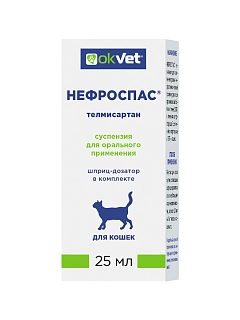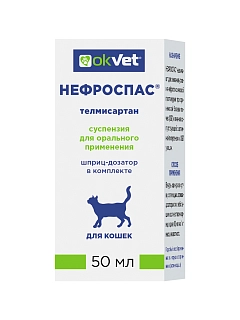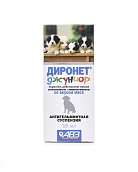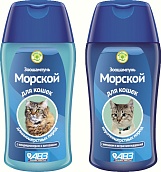Product benefits:
- DESIGNED SPECIFICALLY FOR CATS
- IMPROVES THE QUALITY OF LIFE of cats with chronic kidney disease (CKD)
- COMFORTABLE TO USE thanks to the syringe dispenser included
- CONVENIENT APPLICATION SCHEME - once a day
- ECONOMICAL CONSUMPTION - the volume of the bottle lasts for a long time
- SUITABLE FOR LIFELONG USE - the duration of the course of treatment is not limited
Chemical composition and pharmacological properties
Nephrospas in 1 ml contains telmisartan – 10 mg as an active ingredient and excipients: propylene glycol, maltitol, benzalkonium chloride, purified water.
Telmisartan, which is part of the drug, is a specific antagonist of angiotensin II type AT1 receptors, which causes a dose-dependent decrease in arterial blood pressure in mammals, including cats with chronic kidney disease, and a gradual decrease in proteinuria.
Telmisartan displaces angiotensin II from its connection with the AT1 receptor, selectively binds to the AT1 receptor and does not connect with other AT receptors. Stimulation of the AT1 receptor is responsible for the pathological effects of angiotensin II in the kidneys and other organs associated with angiotensin II, such as vasoconstriction (narrowing of blood vessels), sodium and water retention, increased synthesis of aldosterone and proteinuria. At the same time, the effects associated with stimulation of the AT2 receptor, such as vasodilation, natriuresis and inhibition of inappropriate cell growth, are not suppressed. The binding of the receptor persists for a long time due to the slow dissociation of telmisartan from its connection with the AT1 receptor. Telmisartan does not exhibit agonist activity to the AT1 receptor, does not affect the excretion of potassium in chronic kidney disease.
With oral administration of the drug to cats, telmisartan is rapidly absorbed into the systemic circulation, reaching maximum concentrations of about 62.6 ng / ml 1.5-2 hours after administration at a therapeutic dose of 1 mg / kg. Telmisartan is detected in blood plasma for 12-32 hours, the half-life is about 7.7 hours. Absolute bioavailability after oral administration is about 33%, binding to plasma proteins (mainly albumin and ɑ-1-acid glycoprotein), more than 99%. Being a lipophilic compound, telmisartan penetrates well into organs and tissues. With prolonged use (for 21 days), clinically significant accumulation of telmisartan in organs and tissues is not observed.
Telmisartan is metabolized in the liver to form pharmacologically inactive glucuronide, and is excreted from the body mainly with feces.
Nephrospas is prescribed to reduce the level of nephrotoxic proteinuria in chronic kidney disease (CKD) and the treatment of concomitant systemic hypertension and CKD in cats.
Contraindications
Contraindications to the use of Nephrospas are hypersensitivity of the animal to the components of the drug, including in the anamnesis, cholestasis, obstruction of the biliary tract, severe liver failure. With caution, the drug is prescribed for chronic heart and liver failure, bilateral renal artery stenosis, hypovolemia, hyponatremia, hyperkalemia, under periodic monitoring of the clinical condition and blood parameters (including serum potassium, sodium and creatinine levels).Nephrospas should not be used for cats during pregnancy and feeding of offspring, as well as kittens younger than 6 months of age.
The drug is not intended for use by productive animals.
Dosage and administration
Nephrospas is administered orally (orally) to cats once a day, forcibly with a syringe dispenser or with a small amount of feed, at a dose of 0.1 ml / kg of animal weight (corresponds to 1 mg of telmisartan per 1 kg of animal weight). The dose of the drug and the duration of the course of treatment is determined by the attending veterinarian, depending on the physical condition of the animal and the course of the disease.
The duration of the course of treatment is not limited.
If one or more doses are missed, Nephrospas should be administered as soon as possible in a therapeutic dose. Do not administer a double dose of the drug to compensate for the missed one.
After selecting the drug, it is necessary to close the bottle tightly, rinse the syringe dispenser with water and let it dry. To avoid possible contamination, use the syringe dispenser only for the use of Nephrospas .
Adverse events
When using the drug Nephrospas in accordance with this instruction, side effects and complications in animals, as a rule, are not observed. If allergic reactions occur, the use of the drug is discontinued and, if necessary, antihistamines and symptomatic agents are prescribed to the animal.In rare cases, cats have belching, vomiting, diarrhea or dilute stools, hypotension, a decrease in the number of red blood cells and, very rarely, an increase in the level of liver enzymes is possible. After the suspension of therapy, these indicators, as a rule, normalize within a few days.
The peculiarities of the drug's action during the first application and upon cancellation were not revealed.
Interaction with other medicinal substances
There were no clinical signs of hypotension during concomitant therapy with amlodipine at the recommended dose to reduce proteinuria in chronic kidney disease (CKD).Information about possible interactions in cats with CKD when using telmisartan and other drugs that affect the renin-angiotensin-aldosterone system (RAAS) (such as angiotensin-P receptor blocker (ARB) or angiotensin converting enzyme (ACE)) missing.
There is no information about the incompatibility of the drug with drugs of other pharmacological groups, feeds and known feed additives.
Storage
The drug is stored in the manufacturer's closed packaging, protected from direct sunlight and inaccessible to children, at a temperature from 2 ° C to 25 ° C.
The information provided in this catalog is for reference only. There may be some changes in the characteristics, packaging and packaging of products.
AVZ reserves the right to make such changes without notice. You can get full information about the updated products from your personal manager or your nearest AVZ dealer.
All drugs for veterinary use from this catalog may be contraindicated and when using it is necessary to familiarize yourself with the Instructions for Use.

















